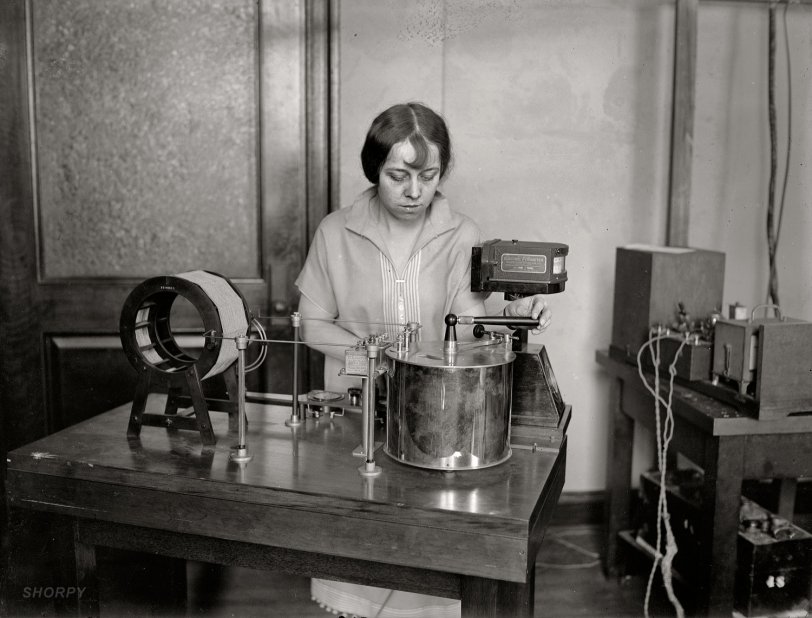


Framed or unframed, desk size to sofa size, printed by us in Arizona and Alabama since 2007. Explore now.
Shorpy is funded by you. Patreon contributors get an ad-free experience.
Learn more.

- Baldwin 62303
- Baldwin VO-1000
- Cold
- No expense spared
- Tough Guys
- Lost in Toyland
- And without gloves
- If I were a blindfolded time traveler
- Smoke Consumer Also Cooks
- Oh that stove!
- Possibly still there?
- What?!?
- $100 Reward
- Freeze Frame
- Texas Flyer wanted
- Just a Year Too Soon
- WWII -- Replacing men with women at the railroad crossing.
- Yes, Icing
- You kids drive me nuts!
- NOT An Easy Job
- I wonder
- Just add window boxes
- Icing Platform?
- Indiana Harbor Belt abides
- Freezing haze
- Corrections (for those who care)
- C&NW at Nelson
- Fallen Flags
- A dangerous job made worse
- Water Stop
Print Emporium
Miss Grace Hazen: 1925

May 19, 1925. "Miss Grace Hazen, Bureau of Standards, testing radio wave meters." National Photo Company Collection glass negative. View full size.
There was a little girl...
...who had a little curl, right in the middle of her forehead.
That said, Miss Hazen was really something. She also co-authored a paper the previous year on "Primary radio-frequency standardization by use of the cathode-ray oscillograph" and was mentioned in the book "Invisible Stars: A Social History of Women in American Broadcasting."
Of Wavelength and Kilocycles
Washington Post, May 17, 1925
Standards Bureau Has Young Woman
As Radio EngineerMiss Hazen's Special Task is Fundamental Standardization of Meters
Makes Her Own Sets: Carries a Portable
Tells of Her work in Laboratory Here; Harmonic Amplifier Is Now Being Used
One of the experts on the staff of the Bureau of Standards radio laboratory is Grace Hazen, 25 years old, assistant physicist, one of very few women who are radio engineers.
Miss Hazen has been at the Bureau of Standards for more than four years. Her particular task is the "fundamental standardization of frequency meters." Born just 18 miles from the "Thousand Islands" in upper New York, Miss Hazen received her B.S. degree at St. Lawrence University
"My father was a meterologist," says she, "and he taught me to love scientific work. I have always been interested in radio and when I graduated from college I came to Washington with the bureau of standards.
Miss Hazen makes her own sets, although she is more interested in their construction than in tuning in programs. "I enjoy the programs most of all when I am on vacation," says she. "I have built myself a small portable with which I can pick up plenty of amusement.
Miss Hazen was recently requested to deliver an address through a local station on her work in the radio field. She declared later that it was "lots easier than facing a huge audience."
"It has been the work of the radio laboratory," says Miss Hazen, "to determine what the meter or kilocycle is in terms of fundamental standards in order to have a standard of radio frequency. The meter is a unit of length, a little long then a yard, used to indicate the actual length of the wave produced in space. The kilocycle, on the other hand, is a measure of the number of thousands of waves transmitted per second. Thus it is a measure of impulses per second or frequency."
...
"To establish the kilocycle directly the bureau of standards uses a tuning fork as a basic standard. Its frequency is first accurately determined by comparison with a fundamental standard of time. The tuning fork is placed in an electron tube circuit so that its frequency controls the frequency of electrical output. Thus a tuning fork of 1,000 cycles per second, which is approximately twice as high a frequency, or pitch, as middle C, will give an electrical output of the same frequency 1,000 cycles per second. This is equal to a kilocycle, which is equivalent to a wave length of 300,000 meters.""The radio laboratory is now using a harmonic amplifier to step the tuning-fork frequency up to radio frequencies. This amplifier increases the current strength and distorts the wave form so that more harmonics are produced than would naturally be present in the tuning-fork output. The amplifier is tuned to some harmonic of the 1,000 cycle tuning fork, for example, the tenth. This frequency of 10 kilocycles is in the radio range and a reading is taken on the wavemeter corresponding to this value."
...
"The bureau of standards has used several other methods in comparing a fundamental frequency with the wavemeters as well as those described. The wavemeters thus standardized are called primary standards. They give the basis for all comparison work, such as determining the frequency of broadcast stations which are announced as standard frequency stations.(Copyright, 1925, by Stevenson Radio Syndicate.)
Grace Hazen Ruark
Miss Grace Hazen went on to marry Arthur Ruark, a physicist attached to the Bureau of Standards who went on to become head of the physics department at UNC. She died in 1967.
























On Shorpy:
Today’s Top 5